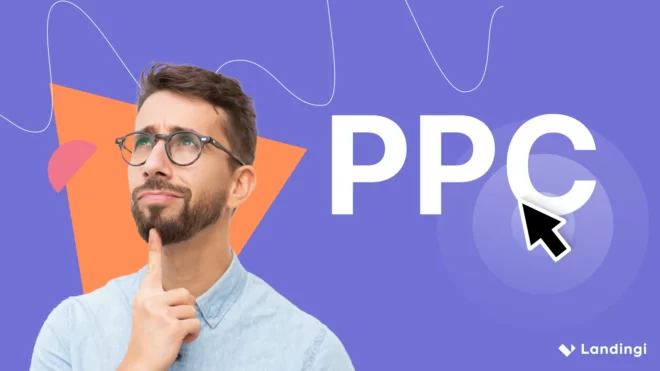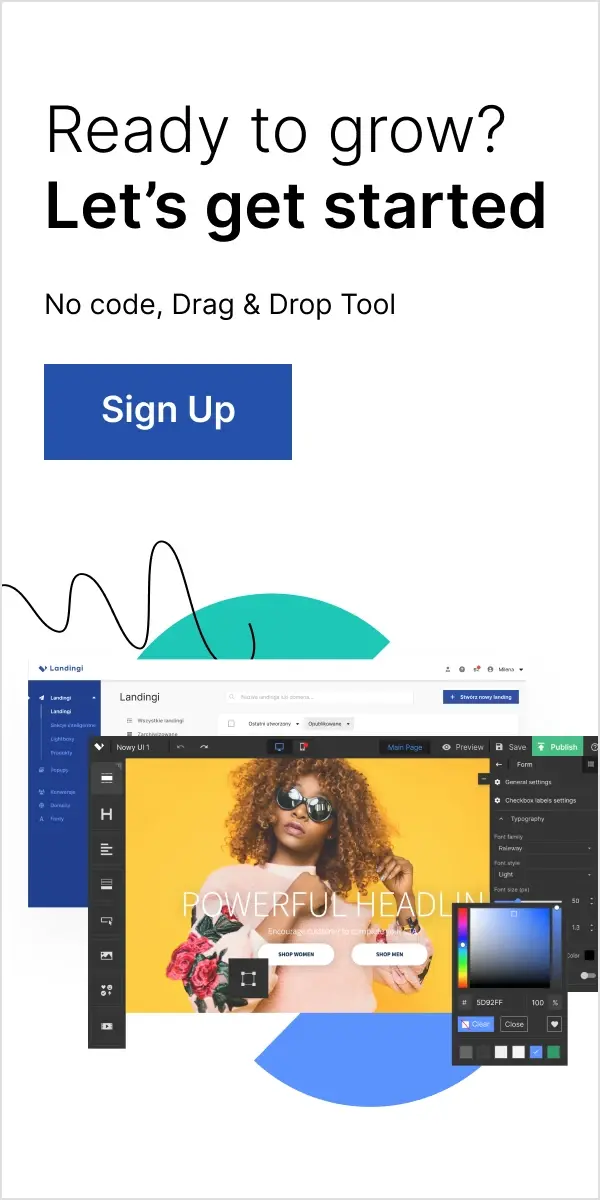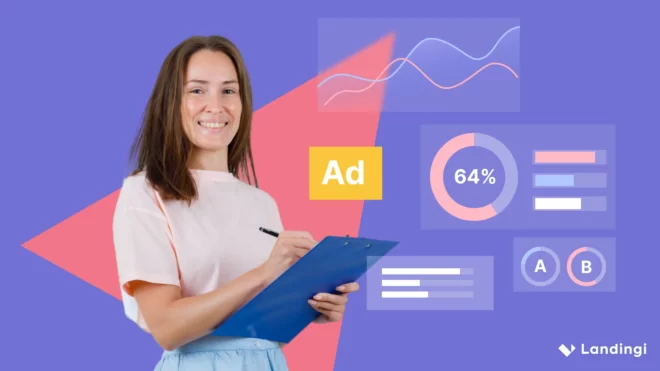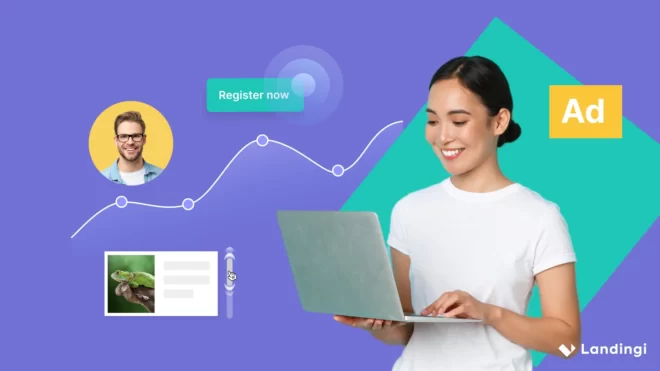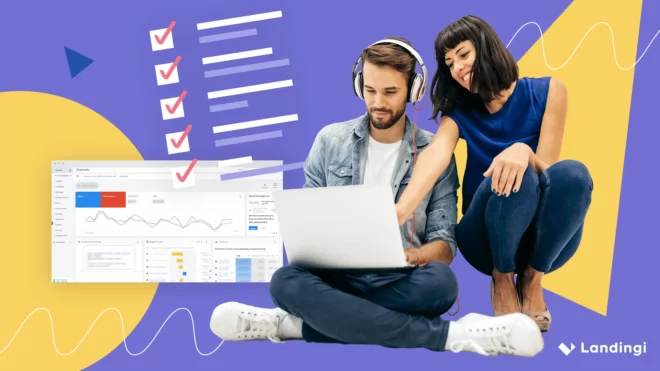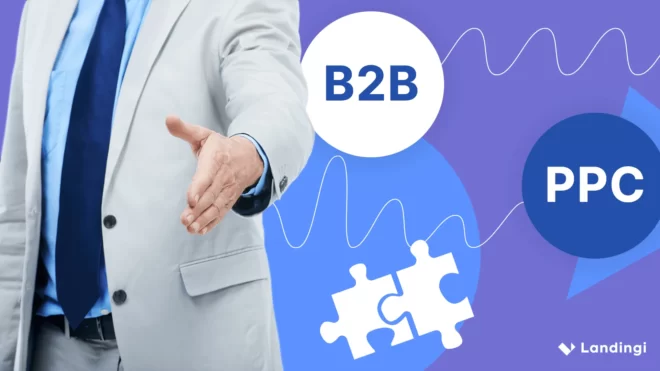Pay-per-click (PPC) in digital marketing allows businesses to buy visits to their websites instead of earning them organically. This article will explain PPC, its types, costs, examples, and purpose, providing a comprehensive understanding of how PPC works and its significance in online marketing. Additionally, we will spotlight Landingi as the best tool for creating landing pages and optimizing conversions – a “critical role in converting paid traffic into leads,” as Kelvin Newman said.
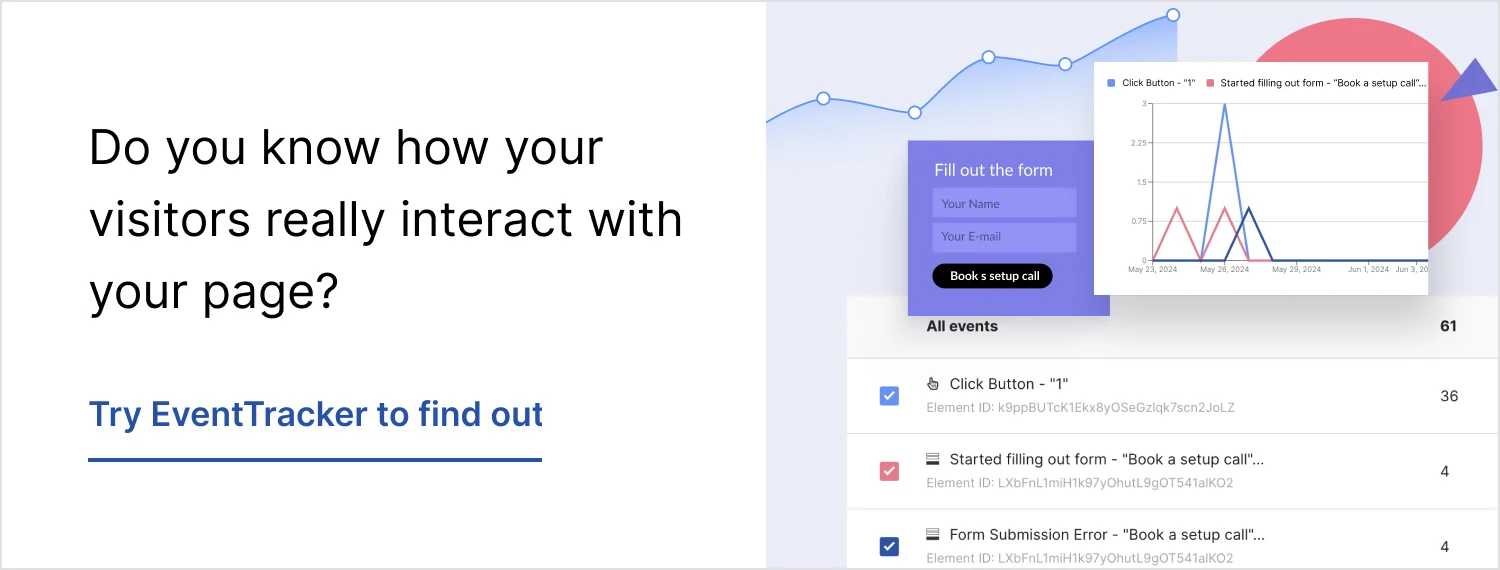
What is PPC (Pay-Per-Click) Advertising?
Pay-Per-Click (PPC) advertising is a digital marketing strategy where advertisers pay a fee each time their ad is clicked. Essentially, it’s a method of buying visits to your site rather than attempting to earn them organically. In PPC, advertisers participate in an auction process to bid on keywords relevant to their products or services. The search engine or platform then determines which ads are shown and in what order based on the bids and the quality of the ads. This method helps businesses attract targeted traffic and achieve immediate visibility on search engines and other platforms.
How does PPC advertising work?
Advertisers set a maximum bid amount they are willing to pay for ad clicks on their advertisement. The actual cost per click is often lower than the bid and depends on the competition for the keyword. Platforms like Google use a combination of the bid amount and the ad’s quality score to determine the Ad Rank. The quality score is based on factors such as the ad’s relevance to the keyword, the click-through rate (CTR), and the landing page experience.
When a user searches for the keyword, the search engine displays the highest-ranking ads on the results page. Advertisers then pay the bid amount whenever a user clicks on their ad.
Google PPC ads typically appear above organic search results in search listings. See example below:
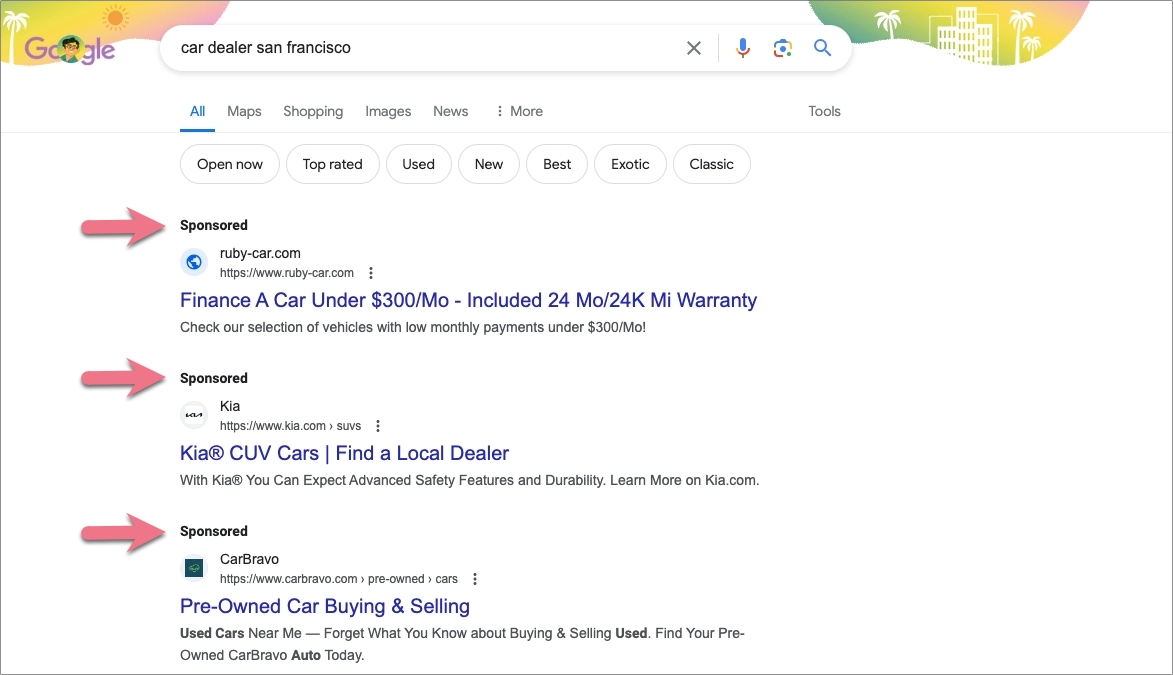
The essential components of PPC advertising include the following:
- Keywords are the terms or phrases that trigger the ad to appear. The choice of keywords is crucial for a successful PPC campaign.
- The ad copy, which is the text or content of the ad, should be compelling and relevant to encourage users to click.
- Landing pages, where users are directed after clicking the ad, must be optimized to convert visitors into customers.
- Bid management involves adjusting bid amounts to ensure the cost-effectiveness of the campaign.
- Targeting allows advertisers to define the audience based on demographics, location, device, time of day, and other factors to reach the right people.
- Budgeting involves setting daily or monthly budgets to control overall ad spend.
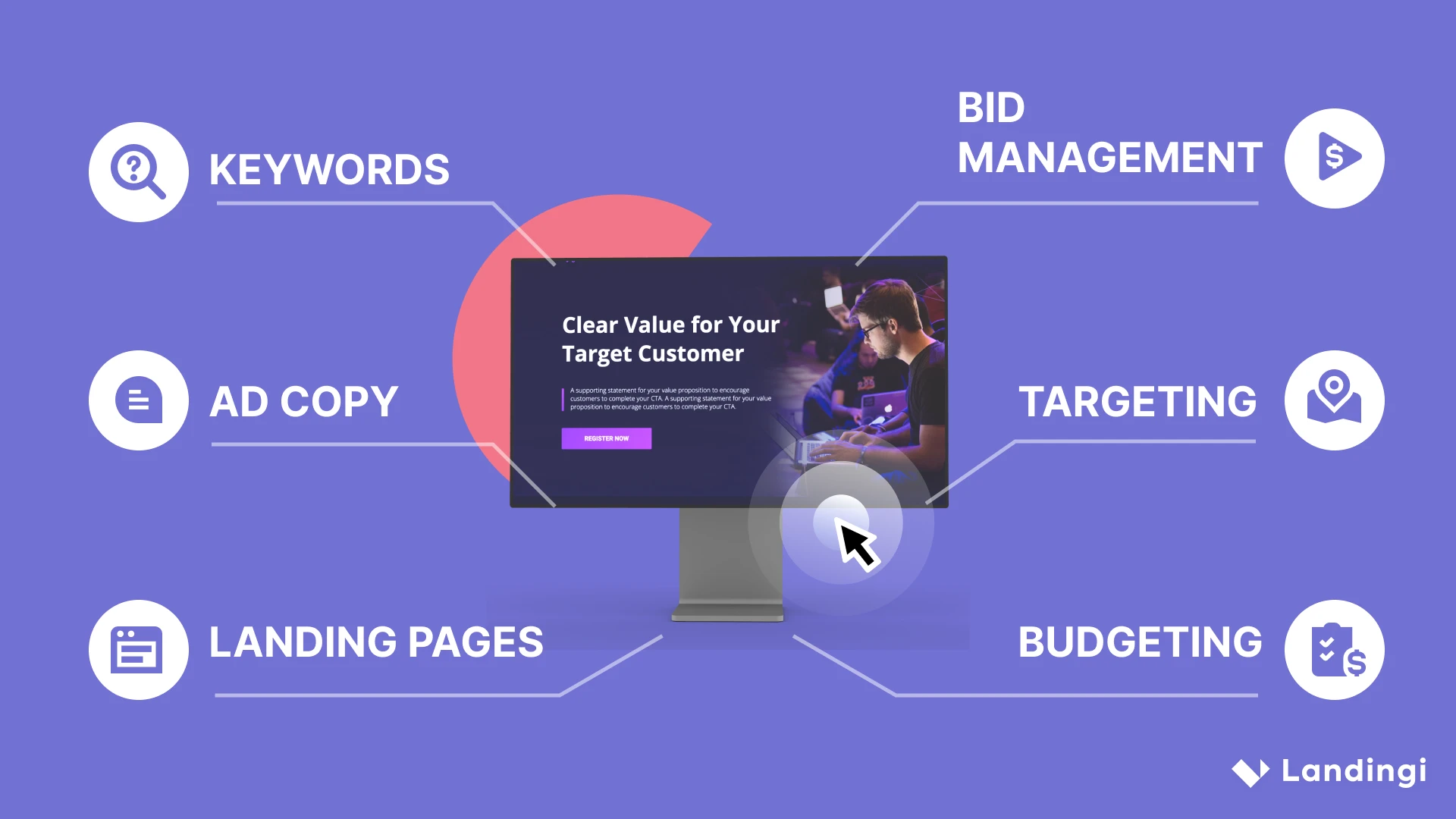
What Does PPC Stand For in Marketing?
In marketing, PPC stands for Pay-Per-Click. This advertising model is widely used to drive traffic to websites, where advertisers pay a fee each time their ad is clicked. PPC is an integral part of digital marketing strategies, providing a direct route to reaching potential customers.
What is The Purpose of Pay-Per-Click Advertising?
The purpose of pay-per-click (PPC) advertising is to drive traffic to websites, increase brand visibility, target specific audiences, generate leads and sales, and convert visitors into customers. It allows businesses to control advertising costs while measuring and optimizing performance, compete with larger brands, support various marketing campaigns, and respond promptly to market trends.
Incorporating ad quality into the mix ensures that businesses not only reach their intended demographic but also deliver content that resonates with their audience, making it easier to boost sales in a cost-effective manner.
Here’s an in-depth look at PPC goals:
Driving Immediate Traffic
Driving immediate traffic is a process of quickly attracting visitors to a website or online platform shortly after initiating marketing efforts or campaigns. It’s the primary purpose of PPC advertising. Unlike organic search strategies, which can take time to build momentum, pay-per-click ads can start generating clicks and visits almost as soon as they are activated. This immediacy is valuable for new product launches, time-sensitive promotions, or events.
Increasing Brand Visibility
Increasing brand visibility and awareness is another crucial goal of PPC advertising. Even if users do not click on the ads, repeated exposure to the brand name, logo, and message can significantly enhance brand recognition. This strategy is particularly effective for new businesses attempting to establish a presence in a competitive market.
Targeting Specific Audiences
Targeting specific audiences through pay-per-click advertising empowers businesses to effectively pinpoint their ideal customer base using a variety of criteria such as keywords, demographics, geographic locations, device types, and even particular times of the day. This precise targeting mechanism guarantees that advertisements are seen by the most pertinent audience, thereby elevating the chances of engagement and conversions.
Generating Leads and Sales
Generating leads and sales is a fundamental aspect of PPC advertising. By funneling potential customers to meticulously crafted landing pages that feature straightforward calls-to-action, businesses have the opportunity to transform visitors into leads or even paying customers. This strategy proves particularly beneficial for e-commerce websites, service providers, and companies with clearly structured sales funnels, enabling them to effectively convert online traffic into tangible business outcomes.
Converting Visitors Into Customers
Converting visitors into customers is a vital aspect of PPC advertising, which excels not just in generating leads but also in effectively transforming those leads into actual sales. It achieves this by targeting individuals who are in the process of searching for particular products or services, directing them to landing pages that are carefully crafted to enhance conversion rates. Due to the instantaneous nature of PPC, these visitors can swiftly transition into customers, frequently leading to a noticeable and quantifiable effect on sales and overall revenue.
Controlling Advertising Costs
Controlling advertising costs permits advertisers to manage their budgets and expenditures effectively. By setting a maximum bid for each click and determining daily or monthly budget limits, advertisers can ensure they stay within their financial boundaries. This aspect of cost control is especially advantageous for businesses of all sizes, enabling them to adjust their advertising efforts according to their financial capabilities.
Measuring and Optimizing Performance
Measuring and optimizing performance enables advertisers to track detailed metrics such as click-through rates (CTR), conversion rates, cost per click (CPC), and return on ad spend (ROAS) in a single coherent approach. This data wealth helps marketers make better-informed decisions about ads, keywords, and the overall campaign approach. Continuously fine-tuning strategies improves performance and helps achieve the best return on investment.
Competing with Larger Brands
Competing with larger brands may seem daunting for small businesses. However, tools like PPC (Pay-Per-Click) advertising offer a unique advantage. Despite smaller budgets, these businesses can target niche keywords and specific audiences, leveling the playing field. This strategy allows them to gain significant visibility and drive traffic, holding their own in a competitive landscape.
Supporting Marketing Campaigns
Supporting marketing campaigns, PPC advertising can effectively complement various marketing strategies and initiatives. For example, it can work in conjunction with SEO (Search Engine Optimization) efforts to cover both paid and organic search results, thereby increasing overall visibility on search engines. Additionally, PPC can support content marketing strategies by driving targeted traffic to specific blog posts or resources that a business wants to highlight. Furthermore, it can enhance social media marketing campaigns by allowing for precise targeting of users based on their activities and interests on social media platforms.
Responding to Market Trends
Responding to market trends, competitor actions, or changes in consumer behavior is crucial for businesses looking to maintain relevance and competitiveness in the market. The flexibility of PPC methods provides an invaluable tool for achieving this. With PPC, campaigns can be quickly adapted, paused, or reactivated as needed, allowing businesses to respond dynamically to the ever-changing market landscape. This adaptability ensures that companies can efficiently allocate their advertising budgets to the most effective strategies at any given time.
What are the Benefits of Using PPC Ads?
The benefits of PPC ads include immediate visibility on search engines and precise targeting capabilities. Additionally, PPC campaigns are easily measurable and adjustable, allowing for constant optimization to improve performance. Businesses can control their budgets effectively and see quick results from their advertising efforts.
Take a look at 5 main benefits of using PPC advertising below:
- Immediate Results: Unlike SEO, which can take months to show results, PPC can drive traffic almost instantly once the campaign is live.
- Targeted Reach: Advertisers can target specific audiences based on various factors, ensuring the ads reach potential customers.
- Measurable ROI: Detailed analytics allow advertisers to track the performance of their ads and adjust strategies in real-time.
- Cost Control: Advertisers have control over how much they spend by setting budgets and bid amounts.
- Flexibility: Campaigns can be quickly modified to respond to market changes, competitor actions, or performance data.
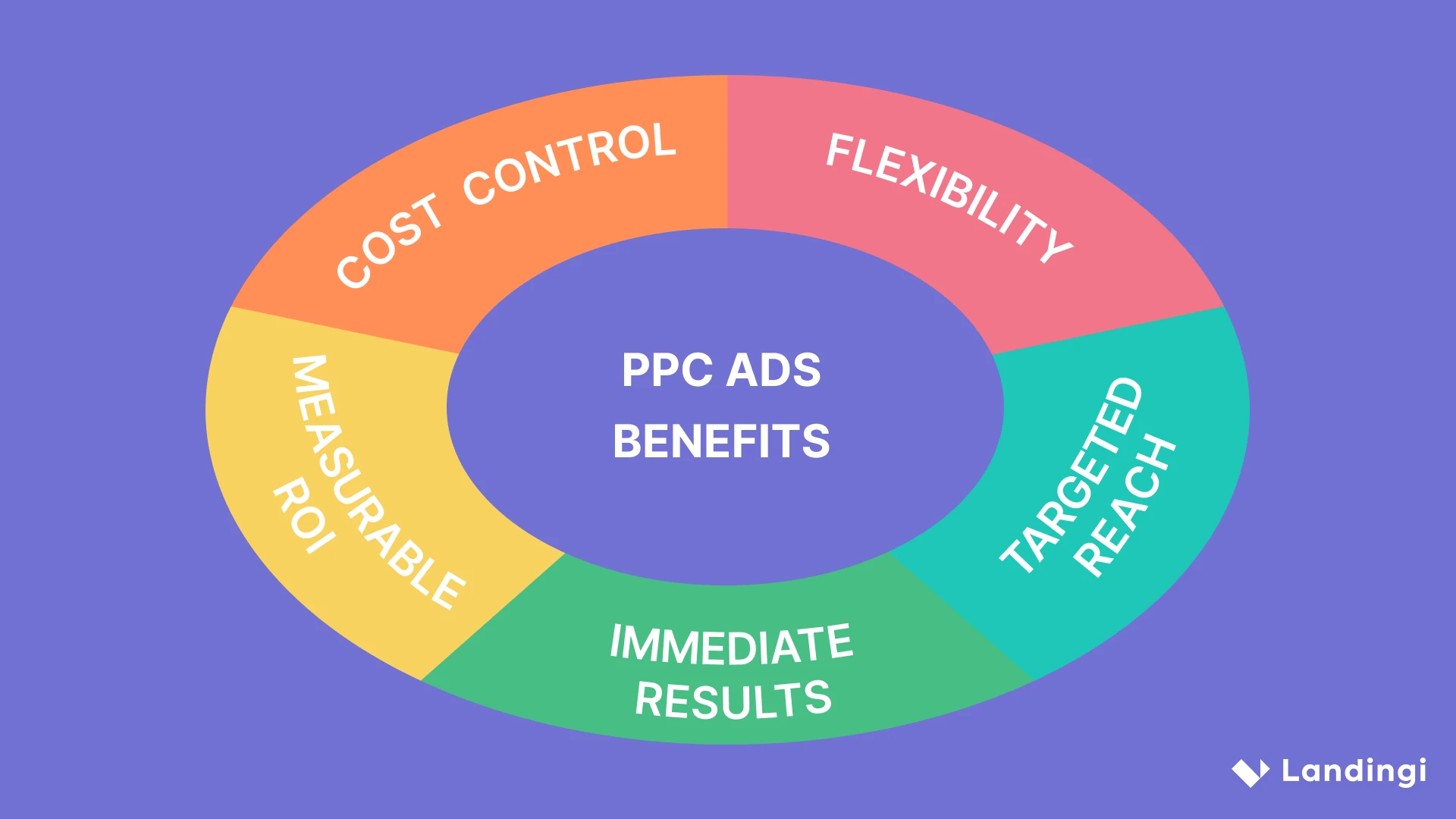
Where to Create a PPC Campaign?
PPC campaigns can be created on online platforms, such as Google Ads, Bing Ads, and social media networks. These platforms provide the tools and features needed to effectively design, launch, and monitor your PPC campaigns. Each platform offers unique advantages and can be chosen based on the target audience and campaign goals.
The largest and most popular PPC platform is Google Ads, which displays ads on Google search engine results pages and partner sites. Bing Ads operates similarly but for the Bing search engine. Social media platforms like Facebook, Instagram, LinkedIn, and Twitter also offer PPC advertising with targeting options based on user profiles and behaviors.
How to Create PPC Marketing Campaign?
To create a PPC marketing campaign, start by defining your goals, choosing a PPC platform, and conducting keyword research to identify relevant search terms. Next, set a budget and design compelling ad copy, then create landing pages for each ad or ad group. Finally, set up ppc tracking and analysis and launch your campaign. Optimize and monitor the performance of your ads regularly and make necessary adjustments. As you collect and refine your campaign data, search for opportunities to scale.
Below is a 10-step guide to help you create PPC campaigns successfully:
Step 1: Define Your Goals. Before you start, clearly define what you want to achieve with your PPC campaign. Common goals include increasing website traffic, generating leads, boosting sales, or raising brand awareness. Your goals will guide the rest of your campaign setup.
Step 2: Choose Your PPC Platform. Select the platform where you want to run your PPC ads. The most popular platforms are Google Ads and Bing Ads for search engines, and social media platforms like Facebook, Instagram, LinkedIn, and Twitter. Your choice should align with where your target audience spends their time.
Step 3: Conduct Keyword Research. Identify the keywords relevant to your products or services. Tools like Google Keyword Planner, Ahrefs, and SEMrush can help you find keywords with the right balance of search volume and competition. Focus on keywords that potential customers are likely to use when searching for what you offer.
Step 4: Set a Budget. Determine your overall budget for the PPC campaign and allocate it across different ad groups and keywords. Decide on your maximum cost-per-click (CPC) bid and set daily or monthly budget limits to control spending.
Step 5: Create Compelling Ad Copy. Write engaging and relevant ad copy that includes your target keywords. Your ads should have a clear headline, a concise description, and a strong call-to-action (CTA). Ensure your ad copy aligns with the user’s search intent and offers a solution to their problem.
Step 6: Design Effective Landing Pages. Create dedicated landing pages for each ad or ad group. These pages should be optimized for conversions and provide a seamless experience from the ad click to the desired action (e.g., making a purchase or filling out a form). Ensure that the landing pages are relevant to the ad copy and keywords.
Step 7: Set Up Tracking and Analytics. Implement tracking tools like Google Analytics and conversion tracking codes to monitor the performance of your PPC campaign. Set up goals and conversion tracking to measure key metrics such as clicks, impressions, CTR, CPC, and conversion rates.
Step 8: Launch Your Campaign. Once everything is set up, it’s time to create campaigns and launch your PPC initiative. Monitor it closely, especially in the initial days, to ensure that it is running smoothly and that there are no issues with ad delivery or budget consumption.
Step 9: Monitor and Optimize. Review your campaign’s performance data regularly. Look at metrics like CTR, conversion rate, CPC, and ROI to identify what is working and what is not. Use A/B testing to experiment with different ad copies, keywords, and landing pages. Adjust your bids, keywords, and targeting based on the performance data.
Step 10: Scale Your Campaign. As you gather data and refine your campaign, look for opportunities to scale. This might involve increasing your budget, expanding your keyword list, or targeting new audience segments. Continue to optimize and experiment to improve performance and achieve your goals.
Example PPC campaign setup on Google Ads account:
- Create a Google Ads Account: Go to ads.google.com and sign up for an account.
- Set Up Campaign: Click on the “+ New Campaign” button, select your campaign goal (e.g., website traffic), and choose the campaign type (e.g., Search Network).
- Define Campaign Settings: Set your location targeting, language, budget, and bidding strategy.
- Create Ad Groups: Organize your campaign into ad groups based on themes or product categories. Select relevant keywords for each ad group.
- Write Ads: Create multiple ad variations for each ad group. Write compelling headlines, descriptions, and CTAs. Use ad extensions to add more information to your ads.
- Set Up Billing: Enter your payment information to fund your campaign.
- Launch: Review all settings and launch your campaign.
What are the Best Tools for PPC Advertising?
The best tools for PPC advertising are Google Ads, SEMrush, and Landingi.
Google Ads stands out as a crucial platform for managing and optimizing PPC campaigns across the Google network, enabling advertisers to reach a vast audience with precision and efficiency.
SEMrush is invaluable for gaining insights into competitors’ strategies and conducting comprehensive keyword research, helping to inform and refine your PPC approach.
Landingi is one of the best PPC tools, renowned for its all-encompassing landing page builder designed to optimize conversion rates effectively. It provides a comprehensive suite of user-friendly tools and templates, streamlining the design process of impactful landing pages that engage your target audience and amplify your PPC achievements.
Other useful tools for PPC marketing are Ahrefs, SpyFu, AdEspresso, Google Analytics, Google Keyword Planner, WordStream, Optmyzr, Microsoft Advertising, and Adalysis.
What is the Cost of PPC Campaign?
The cost of a PPC campaign varies from $100 to $10,000 per month for 45% of businesses, according to WebFX’s PPC Pricing report for 2024. In a similar PPC Pricing report for the year 2023, Clicta Digital estimated that PPC campaign costs ranged from $300 to $5,000 per month. This indicates that the range of costs is wider, as are the strategies for using pay-per-click advertising. The PPC cost varies based on factors such as industry competition, keyword selection, and geographical targeting.
Consider your budget and desired outcomes when estimating costs. Effective budgeting ensures that the campaign remains cost-efficient while achieving the desired reach and impact.
How to estimate PPC advertising costs?
To estimate PPC advertising costs, analyze keyword competition and average cost-per-click (CPC) in your industry. Use tools like Google Keyword Planner to get accurate estimates. Additionally, consider your daily or monthly budget and the expected number of clicks to predict overall expenses.
Wordstream has gathered data on PPC benchmarks, indicating that the average CPC across all industries in 2024 is $4.66. Below are the CPC benchmarks by industry:
- Attorneys & Legal Services – $8.94
- Home & Home Improvement – $6.96
- Dental & Dental Services – $6.82
- Business Services – $5.37
- Industrial & Commercial – $4.95
- Personal Services – $4.95
- Physicians & Surgeons – $4.76
- Health & Fitness – $4.71
- Career & Employment – $4.53
- Education & Instruction – $4.39
- Animals & Pets – $3.90
- Beauty & Personal Care – $3.56
- Apparel/Fashion & Jewelry – $3.39
- Automotive (Repair, Service & Parts) – $3.39
- Furniture – $3.29
- Finance & Insurance – $3.00
- Shopping, Collectibles, and Gifts – $2.61
- Sports & Recreation – $2.34
- Automotive (For Sale) – $2.34
- Restaurant & Food – $2.18
- Real Estate – $2.10
- Travel – $1.92
- Arts & Entertainment – $1.72
How much do PPC services cost?
PPC services typically cost between $9,000 and $10,000 per month for small and medium-sized businesses, as stated by Melody Sinclair-Brooks in her article “How Much To Charge for PPC Management?” for AgencyAnalytics. The cost of managing such an online advertising model can vary significantly depending on the ad spend. Agencies typically charge a percentage of the amount spent on ads, commonly between 10% and 20%, in addition to the ad spend. However, some of the best PPC agencies may charge up to 100%, as mentioned by Louis Halton Davies in his article “How Much Does It Cost To Hire a PPC Agency?” for Web Marketer.
Another source, Clutch, displays the pricing broken down by PPC ad types in their “PPC Pricing Guide 2024.” They state that the average hourly cost of PPC services is as follows:
- Spotify, Baidu, Yahoo, YouTube, and Amazon advertisers pay $25 to $49 per hour
- Bing, Google advertiser pays $100 to $149 per hour
What is the PPC cost formula?
The PPC cost formula involves multiplying the number of clicks by the cost per click (CPC). For example, if your CPC is $2 and you receive 100 clicks, your cost will be $200. On the other hand, the CPC cost is determined by several factors, including the advertiser’s bid, the ad’s Quality Score, and the competition for the keyword.
The basic formula for calculating the cost per click is:
where:
- Competitor Ad Rank is the Ad Rank of the next highest competitor in the auction. Ad Rank is calculated by multiplying the bid amount by the Quality Score.
- Your Quality Score is a measure used by search engines like Google to determine the relevance and quality of your ad and landing page. The Quality Score is influenced by factors such as click-through rate (CTR), ad relevance, and landing page experience.
- +$0.01 is a common practice in the PPC auction model to ensure you only pay slightly more than the minimum required to beat the competitor’s Ad Rank.
What are the Key Types of PPC Ads?
The key types of PPC ads include search ads, display ads, shopping ads, social media ads, video ads, Gmail ads, remarketing ads, and Amazon ads. Understanding PPC types is essential for any digital marketing strategy aiming for success.
Search Ads appear on search engine results pages (SERPs) when users search for specific keywords. They are a form of paid search and a key strategy in pay-per-click marketing, showing up within the search engine’s sponsored links. These ads are utilized primarily to capture user intent and significantly increase traffic to a website. For instance, when a user looks up “best running shoes,” an advertisement from a shoe retailer might be prominently showcased at the top of the search results, leveraging platforms such as Google Ads and Bing Ads to reach potential customers effectively.
Display Ads, also known as image ads or display advertising, are visual banner ads that make their appearance on websites within the Google Display Network or other display networks. Their purpose is to elevate brand awareness and retarget potential customers across the web through strategic ad placement. For instance, you might see a banner ad for a fitness tracker showcased on a health and fitness blog. This not only enhances the visibility of the product but also ensures it reaches a relevant audience interested in such categories.
Shopping Ads display product images, prices, and merchant information directly in the search results across platforms like Google Shopping and Bing Shopping. Tailored to promote e-commerce products and drive direct sales, this ad format is dynamically triggered by search keywords. For instance, when someone searches for “laptop,” they are immediately presented with visually engaging ads from various retailers, complete with images, prices, and links to make a purchase, thereby streamlining the shopping experience.
Social Media Ads appear on social media platforms, often highly targeted based on user demographics, interests, and behaviors, ensuring the right message reaches the right audience. Regardless of the advertising platform, whether it’s Facebook Ads, Instagram Ads, recognized together as Meta ads, Twitter Ads, or LinkedIn Ads, the purpose remains consistent: to engage users on social media, build brand awareness, and drive traffic or conversions effectively. For example, consider a promoted post on Facebook that targets users interested in vegan recipes, which is a prime instance of how these ads can be utilized to reach a niche audience.
Video Ads are dynamic ads in a video format that appear before, during, or after video content. They are a quintessential strategy for businesses looking to capture their audience’s attention and drive brand awareness or conversions. By opting to run ads in the form of engaging video content across platforms like YouTube, Vimeo, and other video networks, companies can effectively engage with their target audience. An example of this approach is a 15-second video ad for a new smartphone that plays before a YouTube video, showcasing how direct and impactful these advertisements can be in capturing viewer interest.
Gmail Ads are interactive ads that appear in the Promotions tab of a user’s Gmail inbox. Managed on the Google Ads platform, their main purpose is to engage users directly within their email environment, presenting them with promotional offers or information. For instance, a user might encounter a clickable email advertisement promoting a travel deal right within their Gmail Promotions tab. This approach not only captures the user’s attention but also encourages immediate engagement with the content.
Remarketing/Retargeting Ads specifically target users who have previously visited the advertiser’s website or engaged with their content on various platforms, including Google Ads, Facebook Ads, and other ad networks. The primary purpose of these ads is to re-engage potential customers who have demonstrated interest in the past, encouraging them to complete a desired action, such as making a purchase or signing up for a newsletter. An example of this strategy in action is when an ad for a product that a user has previously viewed on a retailer’s website appears on different websites, often utilizing keyword-related targeting to ensure relevance and increase the likelihood of engagement.
Amazon Ads appear on Amazon’s platform, elevating the visibility of various products to potential buyers by prominently featuring them. These advertisements exist as part of Amazon Advertising, a specialized platform specifically designed to boost sales within Amazon’s vast e-commerce ecosystem. For instance, when customers search for kitchen appliances, they might encounter a sponsored product ad for a coffee maker. This strategically placed ad not only catches the eye but also simplifies the journey from discovery to purchase for shoppers browsing through Amazon.
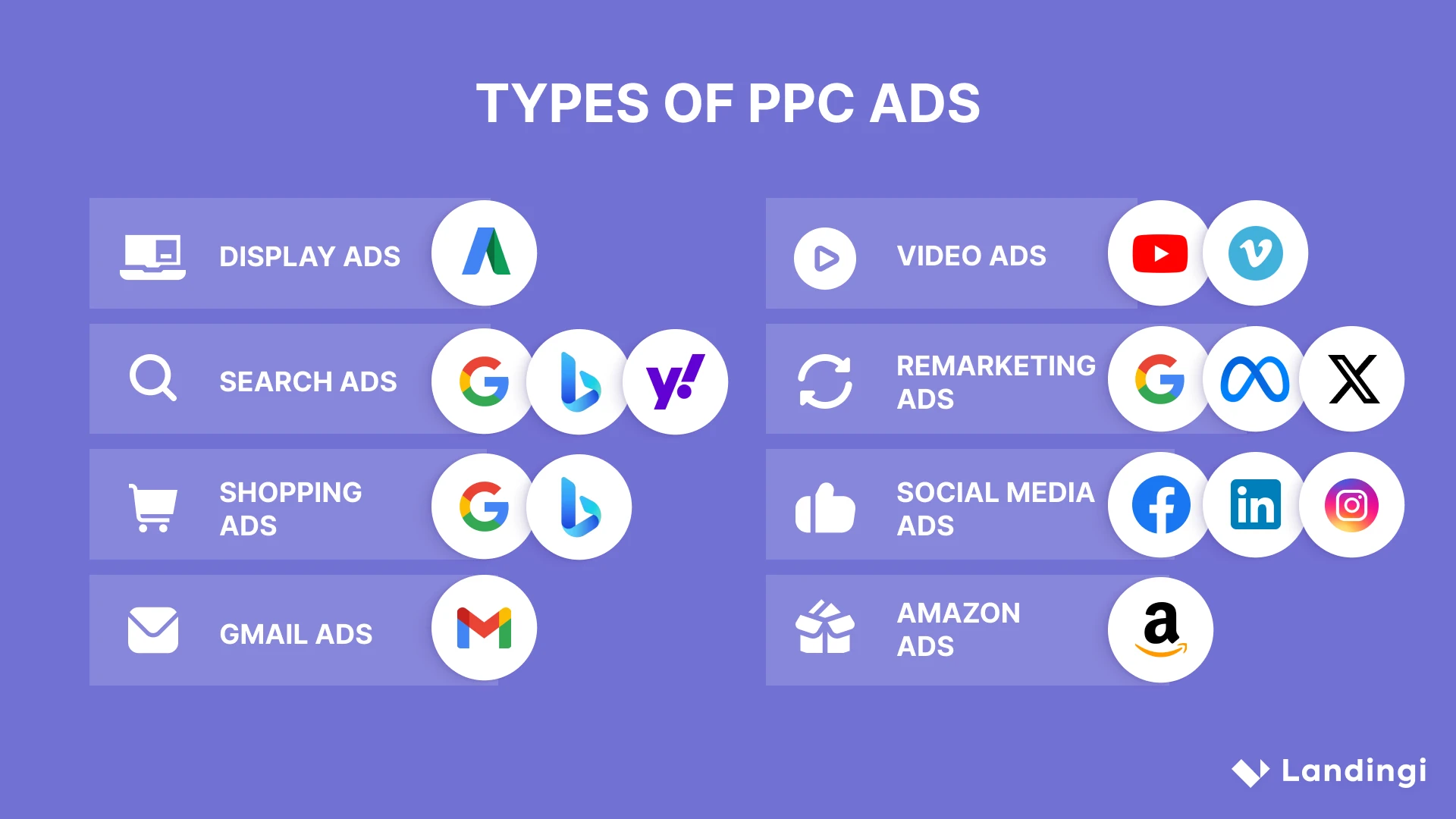
What are the Best Practices for PPC Advertising?
Best practices for PPC advertising include thorough keyword research, creating compelling ad copy, enhancing landing pages, continuously monitoring and optimizing campaigns, and leveraging remarketing. Implementing PPC best practices can significantly enhance the effectiveness of your advertising campaigns.
Here are five best practices to help ensure successful PPC campaigns:
- Conduct Thorough Keyword Research: Identifying the right keywords is crucial for targeting the right audience. Use tools like Google Keyword Planner, SEMrush, and Ahrefs to discover keywords that are relevant to your business and have a good balance of search volume and competition.
- Action Steps:
- Focus on long-tail keywords to capture more specific and intent-driven searches.
- Regularly update and expand your keyword list to include new, relevant terms.
- Use negative keywords to filter out irrelevant traffic and reduce wasted spend.
- Action Steps:
- Optimize Ad Copy and Creatives: Crafting compelling ad copy and attractive creatives is essential for capturing user attention and driving clicks.
- Action Steps:
- Write clear, concise, and persuasive ad headlines and descriptions that highlight the unique selling points (USPs) of your product or service.
- Use strong calls-to-action (CTAs) to encourage users to click on your ads.
- A/B test different versions of ad copy and creatives to determine which performs best.
- Ensure your ads are highly relevant to the keywords and user intent.
- Action Steps:
- Enhance Landing Page Experience: The landing page is where users are directed after clicking on your ad. A well-designed landing page can significantly impact conversion rates. Tools like Landingi are excellent for creating and optimizing landing pages efficiently.
- Action Steps:
- Ensure your landing page is relevant to the ad and provides a seamless user experience.
- Optimize landing page load times to reduce bounce rates.
- Include clear and compelling headlines, images, and CTAs on the landing page.
- Use A/B testing to optimize elements on the landing page for better performance.
- Use Landingi to easily create, customize, and optimize landing pages with its user-friendly interface and powerful features.
- Action Steps:
- Regularly Monitor and Adjust Campaigns: Continuous monitoring and optimization are key to maintaining and improving PPC campaign performance.
- Action Steps:
- Regularly review campaign performance metrics such as CTR, CPC, conversion rate, and ROI.
- Adjust bids based on keyword performance to maximize budget efficiency.
- Pause or remove underperforming keywords and ads.
- Use automated rules and scripts to manage bids and optimize campaigns more efficiently.
- Action Steps:
- Leverage Remarketing: Remarketing targets users who have previously interacted with your website or ads, helping to re-engage potential customers.
- Action Steps:
- Create custom audiences based on user behavior, such as website visits, abandoned carts, or previous purchases.
- Tailor remarketing ads to address the specific interests and needs of these audiences.
- Set frequency caps to avoid overexposure and ad fatigue.
- Use dynamic remarketing to show users ads for the exact products they viewed on your site.
- Action Steps:
What Are the Best Examples of PPC Campaigns?
Best examples of PPC campaigns include successful activities by companies like Snickers, Monday.com, PayPal, and Booking. These campaigns often feature well-researched keywords, engaging ad copy, and high-quality landing pages.
Take a look at the PPC examples below:
1) Snickers – Search ads
This example may not be the newest, but it remains one of the best PPC campaigns in recent years, brilliantly leveraging search engine advertising. Snickers took advantage of spelling mistakes in its search ads. With the help of ad agency AMV BBDO, they managed to get a list of the 500 most searched keywords. They then generated a list of 25,381 different spelling errors. According to Digivate, in just two days, Snickers recorded 558,589 ad impressions. With a click-through rate of 1.05%, 5,874 visitors went to the yourenotyouwhenyourehungry.com mini-campaign landing page.
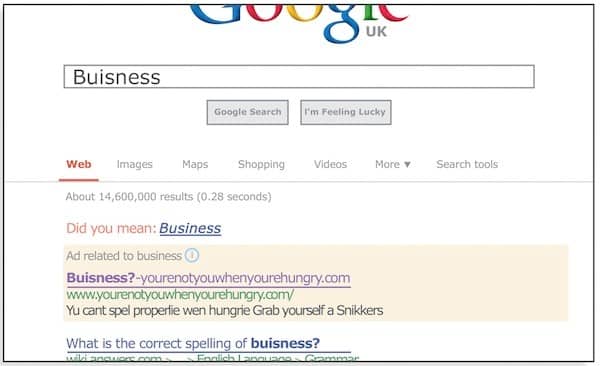
2) Monday.com – Video ads
Monday.com ran a successful campaign on YouTube ads, which garnered a large number of views due to engaging videos that effectively highlighted the value of its product. The ad campaign was well-planned, targeting audiences interested in cloud software and customer management.
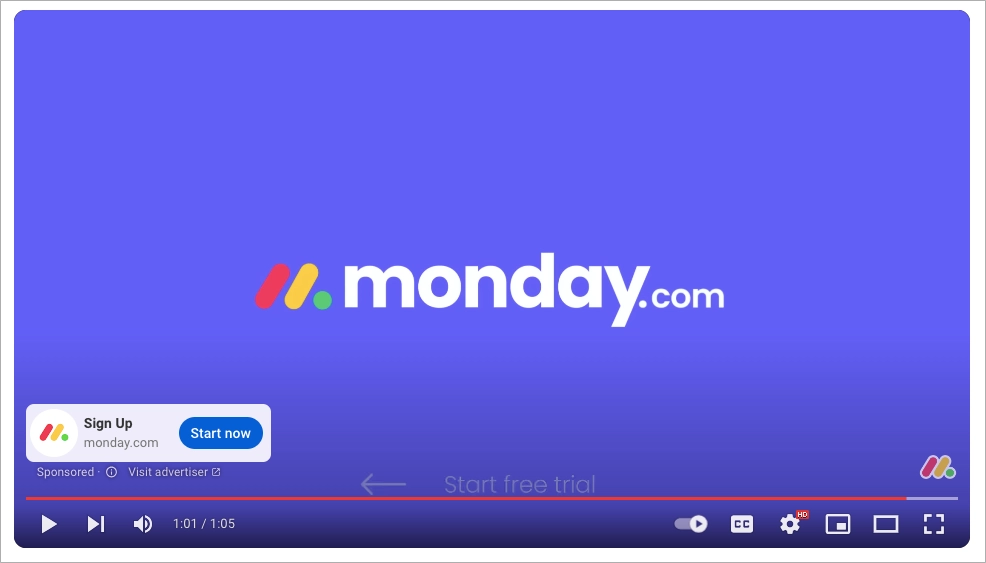
3) PayPal – Display ads
PayPal has utilized advertising space on reputable websites such as Forbes, which focus on business, investing, technology, entrepreneurship, and lifestyle. The display advertising is tailored to highlight the benefits of using PayPal and highlight opportunities for growth. Additionally, it serves as a brand awareness ad, with a “Learn more” button prompting users to explore PayPal’s AI capabilities.
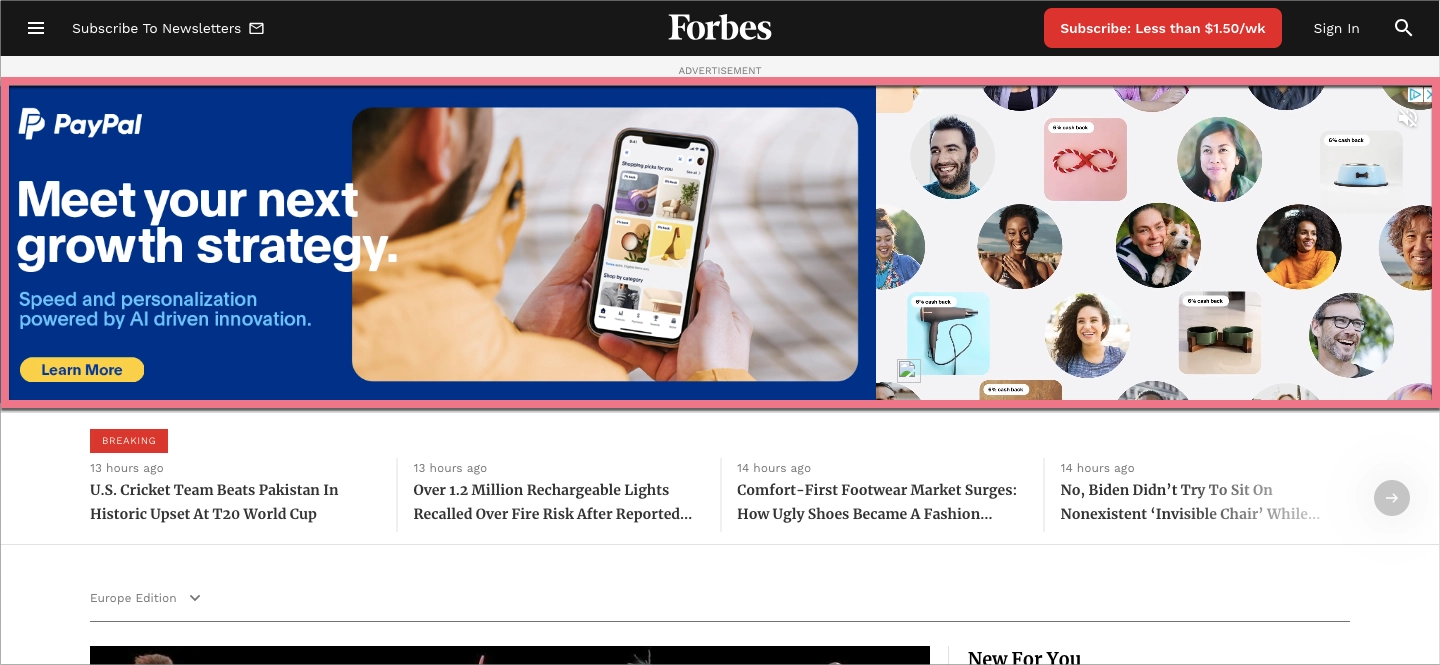
4) Booking – Search ads
Booking is one of the world’s largest travel marketplaces. Despite its strong market position, it faces significant competition. The company utilizes ads in search engine results pages (SERPs) to reach customers looking for hotels in specific countries. For instance, when typing “hotel in Greece” in Google search, the concise headline in the search results immediately informs users about what they can expect upon clicking the link. Additionally, the small accompanying image effectively communicates that the user will find the desired information on the page.
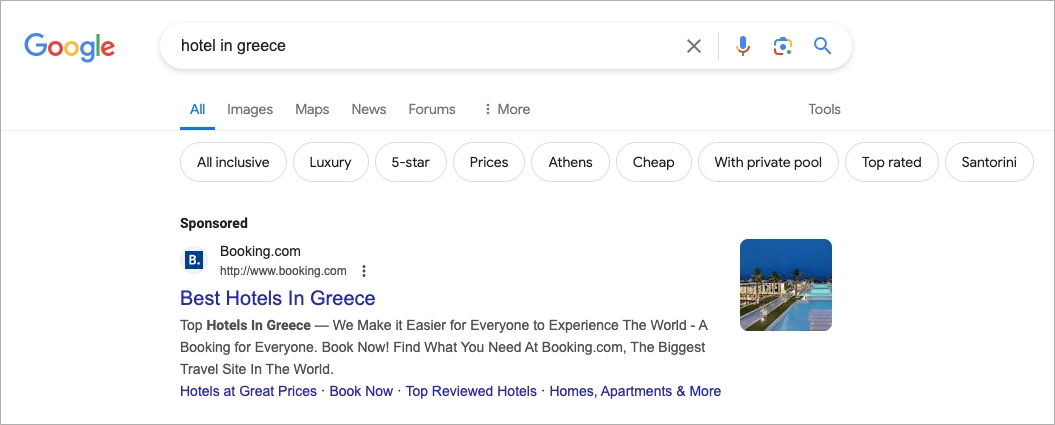
5) KitchenAid – Amazon ads
KitchenAid, a home appliance brand, has effectively capitalized on advertising opportunities on Amazon. Upon searching for “kitchen appliances” within the store, users encounter a prominent interactive banner, which occupies the majority of the initial page view. This banner displays the brand’s popular products with their prices, alongside promotional and product details. Clicking on the advertisement redirects users to the product’s page, facilitating an easy addition of the item to their shopping cart.
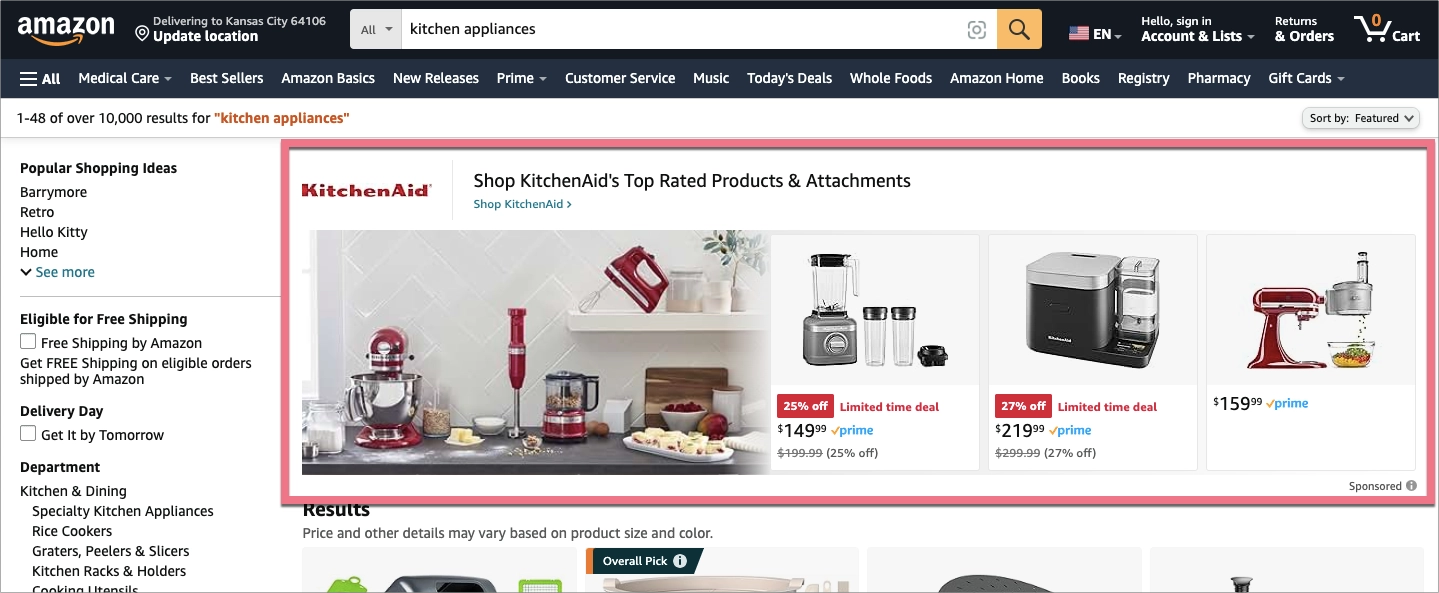
6) Huel – Shopping ads
Huel specializes in easy-to-prepare plant-based meals, snacks, and beverages. To showcase its wide range of products, it has used shopping ads on Google search. This campaign not only directly influences sales by shortening the path to purchase but also supports brand awareness-building activities by showing the variety of products offered by Huel.
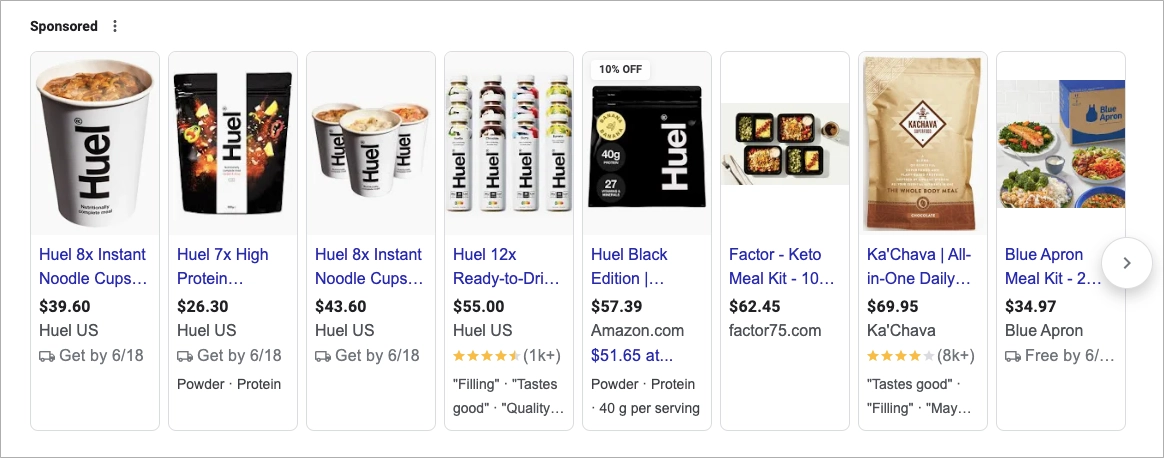
How to Optimize PPC Ads to Increase Conversion Rates?
To optimize PPC ads for higher conversion rates, focus on creating relevant and engaging ad copy, using strong calls-to-action, and ensuring your landing pages are optimized for conversions. Highlight unique selling points clearly, such as “24/7 Customer Support” or “Free Shipping on All Orders.” Personalize your ad copy by using dynamic keyword insertion to make it more relevant to the user’s search query. For instance, if a user searches for “running shoes,” the ad could dynamically update to say, “Shop the Best Running Shoes Now.” Emphasize benefits over features by focusing on what the customer will gain, such as “Boost Your Fitness with Our Lightweight Running Shoes” rather than just listing features.
By focusing on PPC optimization strategies, you can significantly enhance the effectiveness of your PPC campaigns and drive more conversions.
Using strong calls-to-action (CTAs) is crucial. Encourage immediate action with phrases like “Buy Now,” “Get Started Today,” or “Claim Your Discount.” Create a sense of urgency with phrases like “Limited Time Offer” or “Sale Ends Soon” to prompt quicker decisions. Tailor CTAs to the user’s journey stage; for someone in the research phase, use “Learn More” or “Explore Options,” while for ready-to-buy users, “Buy Now” or “Sign Up Today” is more appropriate.
Optimizing landing pages for conversions is another vital aspect. Ensure the landing page message and design are consistent with the ad. If the ad promises “20% off on running shoes,” the landing page should prominently display this offer. Simplify navigation to remove unnecessary distractions and make the desired action, like filling out a form or making a purchase, straightforward. A/B testing is essential – use platforms like Landingi to test different headlines, images, and CTA buttons on your landing pages to see which versions convert better. Additionally, optimize the landing page load times to reduce bounce rates, using tools like Google PageSpeed Insights to identify areas for improvement.
Regular A/B testing and performance analysis are crucial for ongoing optimization. Create multiple versions of your ads with different headlines, descriptions, and CTAs, and compare their performance to identify the most effective elements. Use PPC platform analytics to monitor key metrics such as click-through rates (CTR), conversion rates, and cost per conversion, and adjust your strategy based on these insights. Continuously refine your ads and landing pages based on A/B testing results. If an ad with a particular headline performs better, use that style across other campaigns.
Tailoring ads to match user’s search intent is essential. Segment campaigns by intent, creating separate campaigns for different stages of the buyer’s journey—awareness, consideration, and decision. For example, use educational content for awareness and promotional offers for the decision stage. Match keywords to the user’s intent, targeting specific phrases like “best running shoes for beginners” for research phase users and “buy running shoes online” for purchase intent. Refine ad targeting by using audience insights to tailor your ads to specific demographics or user behaviors, ensuring the message resonates with the intended audience.
Continuously refining keywords is also important. Regularly update your keyword list to include new, relevant terms by using tools like Google Keyword Planner to discover new opportunities. Identify and add negative keywords to prevent your ads from showing on irrelevant searches, thereby reducing wasted spend. Optimize for long-tail keywords as they often have lower competition and higher conversion rates. For example, instead of just targeting “running shoes,” aim for “best running shoes for flat feet.”
How to Perform Keyword Research for PPC Ads?
Keyword research for PPC ads involves identifying the search terms your target audience is using. Tools like Google Keyword Planner, SEMrush, and Ahrefs can help find high-performing keywords relevant to your business. Analyzing competitors’ keywords and considering long-tail keywords can also provide valuable insights for your campaign. Furthermore, successful PPC keyword research can significantly enhance the efficiency and effectiveness of your advertising efforts, leading to better targeting and increased Return on Investment (ROI).
How to Create Landing Page for PPC Ads?
To create a landing page for PPC ads start by ensuring the landing page is highly relevant to the ad content. The design should be clean and distraction-free, guiding the visitor towards the desired action, whether it’s making a purchase, filling out a form, or signing up for a newsletter. Including strong calls-to-action (CTAs) like “Shop Now” or “Claim Your Discount” in prominent locations can help drive conversions. Make sure the landing page loads quickly to prevent potential customers from bouncing before they even see your offer.
Using a platform like Landingi can significantly simplify the process of creating and optimizing your PPC landing page. Landingi provides a user-friendly drag-and-drop interface that allows you to create professional, high-converting pages without needing any coding skills. You can A/B test different versions of your landing pages to determine the best-performing elements, such as headlines, images, or CTAs.
Additionally, Landingi supports e-commerce functionalities, making it easier to create pages that drive online sales. With over 400 templates and 170 integration options, the platform allows you to tailor landing pages to your specific campaign needs and effectively track performance metrics. Using tools like Landingi, you can create landing pages that not only look great but also function seamlessly, enhancing the overall effectiveness of your PPC campaigns.
Where to Create Landing Page for PPC Ads?
Create landing pages for PPC ads using platforms like Landingi. It provides an easy-to-use editor and templates for building high-converting pages. The platform also offers customizable forms, A/B testing, event tracking, Smart Sections, autoresponders, and campaign scheduling. Landingi’s focus on conversion optimization makes it a powerful tool for marketers who want to maximize the effectiveness of their PPC campaigns.
Other options include Unbounce and Leadpages, both of which provide robust features for landing page creation and optimization.
Make your sections smartable and let go of mundane manual tasks with Smart Sections! An easy way to manage bulk changes.
How Does PPC Ads Work?
PPC ads work by allowing advertisers to bid on specific keywords relevant to their target audience, displaying their ads on search engine results pages, websites, or social media platforms. When a user searches for a keyword or browses content related to the advertiser’s bid, the ad is displayed, and the advertiser pays a fee each time the ad is clicked. The cost per click is influenced by the advertiser’s bidding strategy, the ad’s Quality Score (which includes relevance, click-through rate, and landing page quality), and the competition for the keyword. This model ensures that advertisers only pay for actual traffic driven to their websites, making it a cost-effective method to attract potential customers and achieve marketing goals.
How Does PPC Differ From Other Digital Marketing Strategies?
PPC differs from other digital marketing strategies like SEO and content marketing because it involves paying for immediate traffic rather than organically earning it. It’s a quicker way to get in front of your audience, but it requires ongoing investment. SEO focuses on optimizing your site to rank higher in organic search results, while content marketing aims to attract and engage audiences through valuable content.
What’s the Difference Between PPC, SEM and SEO?
PPC (Pay-Per-Click) involves paying for ad placements, SEM (Search Engine Marketing) includes both paid and organic strategies, and SEO (Search Engine Optimization) focuses solely on improving organic search rankings.
PPC is a paid advertising model where advertisers bid on keywords and pay each time their ad is clicked, driving immediate traffic to their website through platforms like Google Ads or Bing Ads. This approach allows for quick visibility and results by paying for ad placement on search engine results pages (SERPs). SEM, being a broader term, encompasses both PPC and SEO, aiming to increase overall visibility on SERPs through a combination of paid ads and organic search efforts.
SEO, on the other hand, is dedicated to optimizing a website to enhance its organic search rankings without direct payment for ad placements. This involves a variety of techniques including keyword research, on-page optimization (such as improving content, HTML code, and structure), and off-page optimization (such as building backlinks and enhancing site authority). Unlike PPC, SEO aims to attract organic traffic by making the website more relevant and authoritative in the eyes of search engines, which typically takes longer to achieve but is more cost-effective in the long run. In essence, while PPC and SEM use paid strategies for immediate visibility, SEO focuses on organic methods for sustainable, long-term traffic growth.
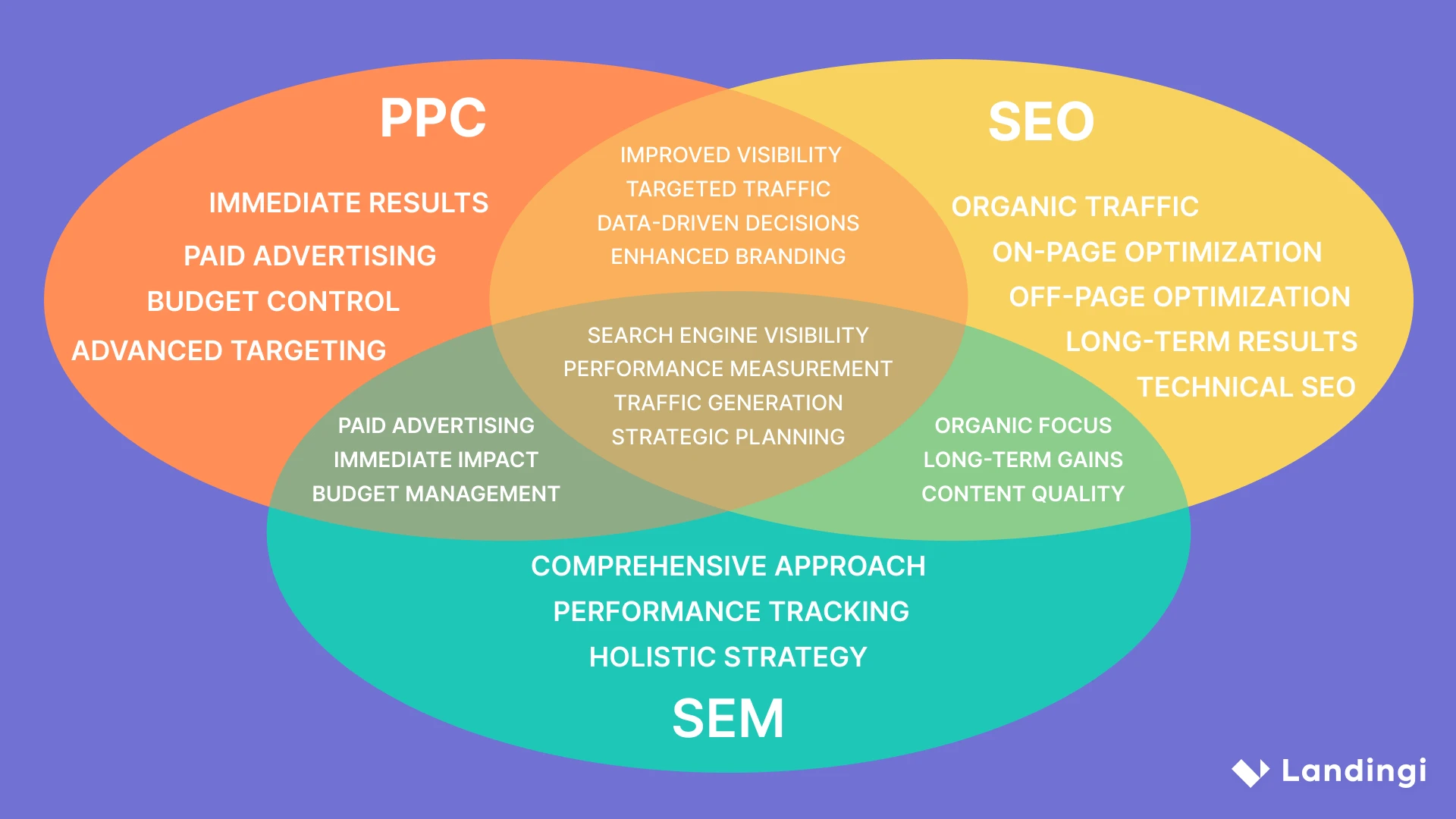
Why is PPC Important?
PPC is important because it provides businesses with immediate visibility and a way to reach their target audience quickly. It’s a powerful tool for driving traffic, generating leads, and increasing sales. Additionally, PPC campaigns offer measurable results, making it easier to track ROI and adjust strategies as needed.
What is the meaning of PPC in business?
In business, PPC refers to a marketing strategy where advertisers pay each time their ad is clicked. This allows for cost-effective budget management and measurable results. It helps businesses attract targeted traffic and achieve their marketing goals efficiently.
What Are the Top PPC Advertising Platforms?
The top PPC advertising platforms include Google Ads, Bing Ads, Meta Ads, LinkedIn Ads, and Microsoft Advertising. Each platform offers unique features and advantages for reaching different audiences. For example, Google Ads is ideal for search engine marketing, while Meta Ads (Facebook Ads) are effective for social media marketing.
How Can I Learn PPC?
You can learn PPC through online courses, tutorials, and certifications offered by platforms like Google and Meta. Additionally, blogs, webinars, and industry forums provide valuable insights and updates. Practical experience through managing your own campaigns or working with an expert can also enhance your understanding.
Online courses from platforms like Udemy, Coursera, and LinkedIn Learning offer structured modules covering basic to advanced PPC strategies, allowing you to learn at your own pace. Additionally, obtaining certifications from Google Skillshop or Meta Blueprint can add credibility to your skills and enhance your career prospects.
Staying updated with industry trends is also crucial. PPC Blogs and websites like Search Engine Journal, PPC Hero, and WordStream provide valuable insights and practical advice from experts. Participating in webinars and workshops hosted by digital marketing agencies and platforms can also deepen your knowledge and keep you informed about the latest PPC strategies and trends.
What Are Some Limitations of PPC Campaigns?
Some limitations of PPC campaigns include the ongoing cost, competition for high-traffic keywords, and the need for constant optimization. Additionally, ad fatigue can reduce effectiveness over time, requiring fresh and engaging ad content. Businesses must also be cautious of click fraud, which can artificially inflate costs.
Conclusions
PPC advertising is a powerful and flexible marketing strategy that provides immediate visibility and drives significant traffic to your website. By understanding the fundamentals of PPC, leveraging advanced tools, and adhering to best practices, you can create effective campaigns that boost growth and visibility. PPC allows for precise targeting and measurable results, making it a cost-effective method for reaching potential customers and achieving marketing goals. The flexibility of PPC campaigns means you can quickly adapt to market trends and optimize their strategies for better performance.
Landingi is an exceptional platform for creating and optimizing PPC landing pages, offering a range of features designed to maximize conversions. Landingi’s A/B testing tool facilitates the comparison of different page versions to identify the top performer, while dynamic content significantly improves user experience. The platform also features an EventTracker for monitoring user interactions, offering insights for optimization, and autoresponders to enhance lead engagement and conversion rates. Additionally, with over 170 integration options, Landingi ensures smooth connectivity with a wide array of marketing tools, alongside a campaign scheduling feature for precise timing control. These benefits highlight why Landingi stands as a comprehensive solution for boosting the effectiveness of PPC campaigns, promising superior outcomes.
Dare to elevate your results? Experience the transformation firsthand by trying Landingi for free today!

